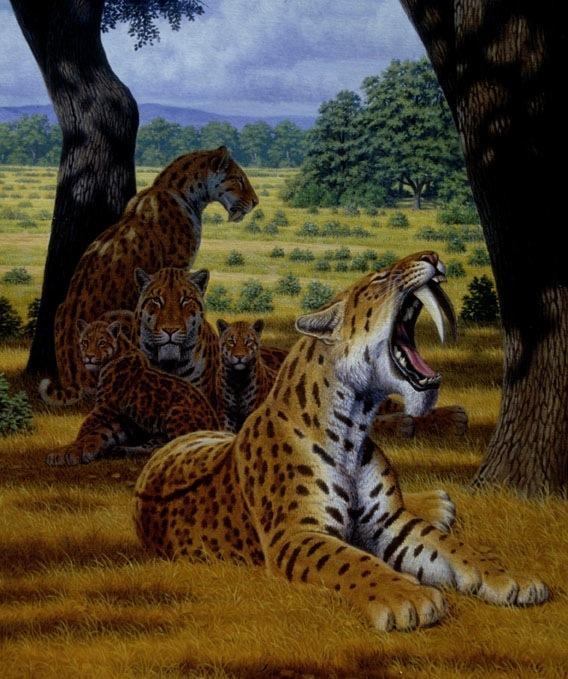Life History
Nutrition
 Smilodon fatalis was a carnivorous predator during
the Pleistocene epoch (Coltrain et al. 2004). Due to their robust physique, they were
believed to have preyed on large, slow moving animals (Coltrain et
al. 2004). Animals
that were within the hunting range of S. fatalis included
but were not limited to : the "yesterday's" camel, bison, pronghorns,
horses, ground sloths, mammoths and mastodons (Coltrain et al.
2004). Ruminant animals such
as the bison and camels were more likely to be hunted by S.
fatalis (Coltrain et al. 2004). To understand how these prey were captured, we have to
understand whether or not Smilodon were social. In this case,
S. fatalis probably was a social species inorder to compete
with other carnivores of the time (Carbone et al. 2009).
Smilodon fatalis was a carnivorous predator during
the Pleistocene epoch (Coltrain et al. 2004). Due to their robust physique, they were
believed to have preyed on large, slow moving animals (Coltrain et
al. 2004). Animals
that were within the hunting range of S. fatalis included
but were not limited to : the "yesterday's" camel, bison, pronghorns,
horses, ground sloths, mammoths and mastodons (Coltrain et al.
2004). Ruminant animals such
as the bison and camels were more likely to be hunted by S.
fatalis (Coltrain et al. 2004). To understand how these prey were captured, we have to
understand whether or not Smilodon were social. In this case,
S. fatalis probably was a social species inorder to compete
with other carnivores of the time (Carbone et al. 2009).
Intraspecific Interactions
Smilodon fatalis was said to have been a social and solitary
species. Most arguments for either case are rigorous but there
is more
research supporting the idea that they were a social species.
According to the fossil records from Rancho La Brea, many Smilodon
bodies were found
together (Carbone et al. 2009). This suggests that Smilodon
hunted in groups as well as having a family structure. Nonetheless, it should be noted that they most likely were
sociable with one another. The social interaction between Smilodon are apparent
even in times of need.
Many
remains of the
saber-tooth
cat show signs of injuries to bones and
areas of muscle attachment that would take weeks to months to heal,
which would prevent a Smilodon from actively hunting. In solitary
creatures, these wounds would mean that the animal could not hunt and
would starve to death; however, most of the remains with injuries
show that these injuries healed or were in the process of healing
(Prehistoric Wildlife 2011).
Accordingly, the Smilodon must have gotten its food from somewhere
while it recovered. The most common accepted hypothesis is that these
prehistoric cats hunted in packs; thus, the food was shared among
the members of the group including the injured (Prehistoric Wildlife
2011).
The
La Brea tar pits also contained multiple sites where young Smilodon
were present in the presence of adult Smilodon and the prey
(Carbone et al. 2009). This
suggests that adolescent Smilodon accompanied the adults during
hunts to learn the strategies and instincts needed for survival
(Carbone et al. 2009).
Maternal care was also a plausible inference since the young could
not hunt until after their teeth erupted (Turner 1997). Scientists also inferred that after
teeth development, the mother would bring live prey for the young to
practice the instinct of biting (Turner 1997). Overall, the family structure was
thought to be quite similar to modern day cats.
To continue the journey, visit
Interactions next!
To return to the Smilodon fatalis homepage, click
here.
